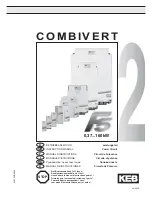
PM50/PM80 INSTALLATION MANUAL
10231-10.doc
Polyamp AB, Sweden
www.polyamp.com
Page
4 (7)
1
Before installation
On the front panel label the following is displayed:
Converter type name, input voltage range, nominal
output voltage, serial number, article number and
batch number. The converter type name consists of
model name PM50 or PM80 followed by input
code and output voltages. Two examples:
•
”Type: PM50B15-15” has input code ”B”
and nominal output voltage 2x(12-16) Vd.c.
•
”Type: PM80 110/24-24” has input code
”110” and nominal output voltage 2x24Vd.c.
Input, outputs and case are galvanically separated
from each other. The two outputs are also
galvanically separated from each other. You can
thus choose how you want the system connected.
The input is protected against reverse polarity by a
parallel diode at the input on models with input
code A, B, 24 and 48. This diode, however, is only
intended to blow an external input fuse. C, D, 110
and 220 input codes have a series diode.
The input shall be fused with an approved fuse
with a slow blow characteristic and high
breaking capacity
. See
Table 1
.
PM50 input fuses
Input voltage code
Time delay fuse
A
T 6.3 A H, 250
B
T 4A H, 250
C
T 1.6 A H, 250
D
T 1A H, 250
PM80 input fuses
Input voltage code
Time delay fuse
24
T 5A H, 250
48
T 3,15 A H, 250
110
T 1.6 A H, 250
220
T 0.63 A H, 250
Table 1. Recommended input fuses.
There are two reasons we do not include the fuse.
1.
DC-networks should be fused at the distribution
point to protect the cable.
2.
Different applications require different types of
fuses.
If the converter is mounted in an electric vehicle, an
external series diode on the input is recommended.
Please contact your Polyamp dealer.
If the converter supplies a DC-motor, we
recommend an external parallel diode at the motor
poles to protect against reverse voltages.
For the disconnection ability, an external
disconnection device, which is able to disconnect
both polarities, shall be incorporated with the input
power supply cord. The disconnection device must
be properly labelled and easy accessible
2
Installation
The converter shall be mounted in an enclosure,
which meets the demands of EN60950 regarding
fire, voltage hazard and mechanical strength.
The converter is supplied with mounting brackets.
With these you can mount the converter in any
direction on a wall or on a DIN 35mm rail.
The converter is convection cooled and in order to
get sufficient cooling there shall be a minimum of
30 to 50 mm space around the converter. If this is
not possible, we recommend the use of an external
fan.
Note that the expected life of the converter is
dependant on converter temperature. For every
10
°
C that the temperature is lowered the expected
life is approximately doubled. It is therefore crucial
to cater for good ventilation and if possible to
reduce ambient temperature.
To meet the EMC specifications in the enclosed
”declaration of conformity” use twisted-pairs for
connecting input and output. Shielded cables are
not necessary.
1.
Connect protective earth to the connection
marked no 17. Use a ring terminal that has been
crimped by an appropriate tool
.
2.
Connect the output. The converter outputs are
short-circuit proof by a constant current limit
which works unlimited in time.
•
Use the supplied jumpers according to
Connecting the outputs for series, parallel or
master/slave operation on page 8.
•
If the converter is to be connected in parallel
with another unit at the output, please consult
Parallel connection of two converters or more
on page 9.
3.
Connect the input cables. Bundle input cables
together at the terminals separated from the
output cables. Make the same arrangement on
the output side. This is to make sure one cable
will not bridge the insulation barrier in case of
coming lose.
4.
Start the converter with your external input
disconnection device.
Beware of hazardous voltages!

























